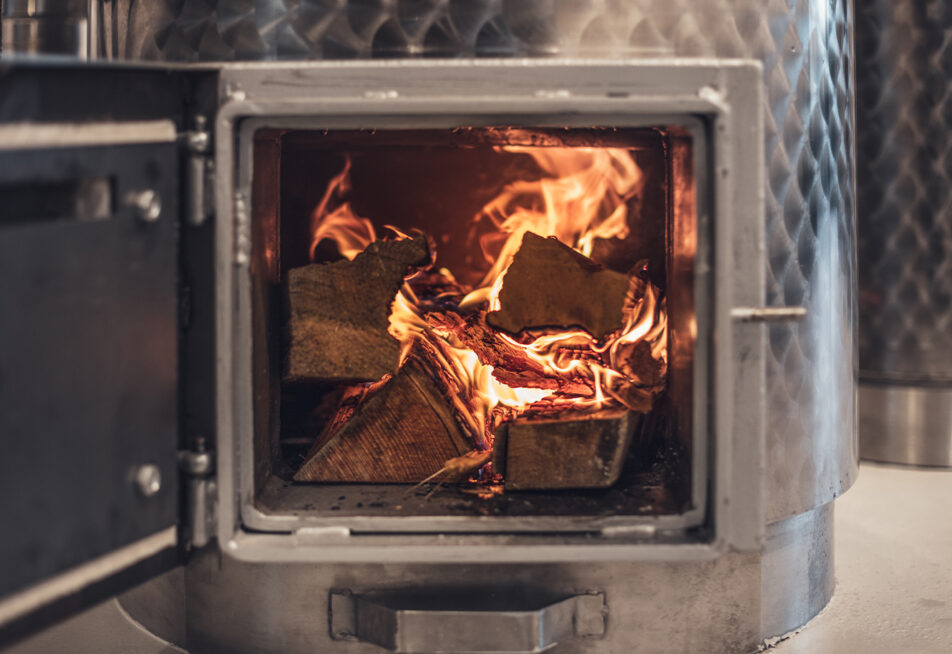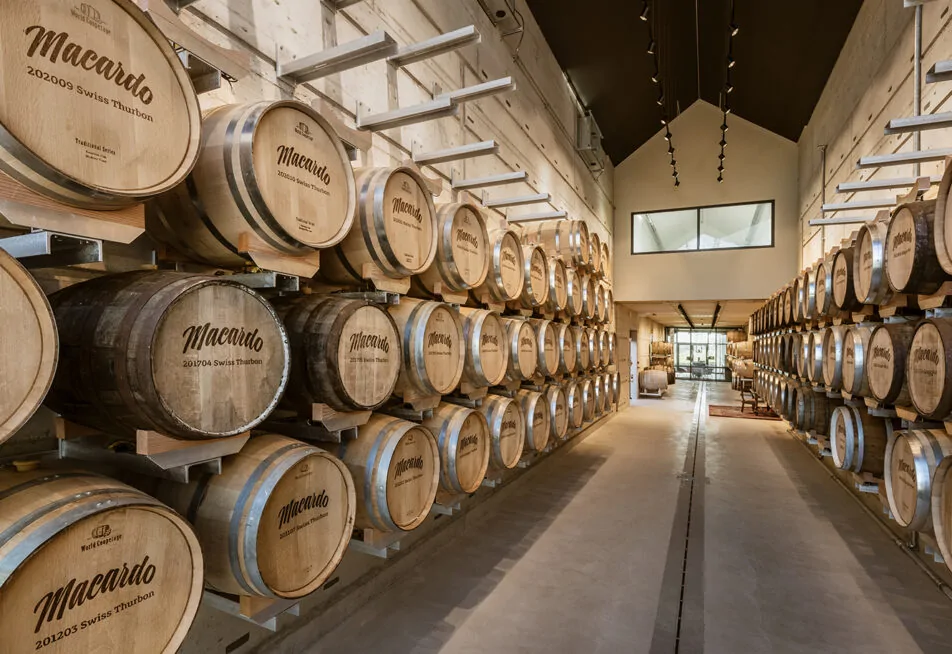Die Highlands von Helvetien
Schweizer Whisky Schottland, Irland und die USA gelten als grosse Whiskynationen. Doch auch in der Schweiz darf seit 1999 Getreide zu Schnaps gebrannt werden. Ein Destilleriebesuch – und vier Trinktipps.
Der hohe Raum hat etwas Sakrales. Es ist leicht kühl, still, verhalten riecht es nach den rund 200 Holzfässern, die links und rechts den Wänden entlang gelagert werden. Wenn er über seine Destillate spricht, hallt die Stimme von Andy Bössow im Raum nach: «Der weltweite Konsum von Whisky ist steigend – für die Schweiz eine Chance, da die Schotten ja kaum mehr mit Brennen nachkommen.»
2007 hat der Unternehmer im thurgauischen Niemandsland begonnen, Whisky zu produzieren. «Drüben in der alten Käserei, wo wir jetzt noch mit Holzfeuer destillieren», so der Chef von Macardo. Die Fässer, in denen der Whisky reife, seien ursprünglich an vier Standorte verteilt worden. Letztes Jahr habe man hier in Strohwilen endlich dieses zentrale Lager eröffnen können, in dem er jetzt stehe.
Wer genauer hinblickt, entdeckt Hightech: Mit Sensoren wird das Gewicht jedes Fasses täglich auf drei Gramm genau gemessen. Ebenso aufgezeichnet werden Luftfeuchtigkeit und Temperatur in den einzelnen Bereichen des Raums; reguliert werden sie mit Quellwasser. «Und all diese Daten», sagt Bössow, «vergleichen wir dann später akribisch mit unseren sensorischen Eindrücken bei der Degustation.»
Die Whiskyherstellung ist ein Lernprozess: Bössow zeigt auf ein einzelnes Fass, das offensichtlich tropft – darunter hat sich ein brauner Fleck gebildet. «Wir haben mit einer geringeren Fassdauben-Dicke experimentiert, 19 statt 25 Millimeter – es war der falsche Ort, um Geld zu sparen.» Nicht umsonst hätten gute Fässer ihren Preis, sagt der Macardo-Chef: «Für ein Pedro-Ximenez-Fass bezahlt man schnell mal tausend Franken.»
Berner waren Pioniere
Angefeuert wird der Markt durch die zahlreichen Produzenten in den grossen Whiskynationen. Das sind nach wie vor die USA, Schottland und Irland; auch Japan hat sich seit der Jahrtausendwende dazugesellt. In der Schweiz wird erst seit rund zwanzig Jahren überhaupt Whisky produziert, bis dahin durften weder Kartoffeln noch Getreide zu Schnaps gebrannt werden, weil die Nahrungsmittelversorgung der Bevölkerung nach dem Zweiten Weltkrieg an oberster Stelle stand.
1999 wurden die Bestimmungen gelockert, Rugenbräu im Berner Oberland gehörte zu den hiesigen Pionieren: In Windeseile lancierten Kurt Althaus und seine Mitstreiter einen Bierbrand, also gewissermassen Whisky ohne Fasslagerung. In einem nächsten Schritt kauften sie ein 500-Liter-Holzfass, 2003 füllten sie daraus den ersten Single Malt ab. «Die rund 700 Flaschen habe ich im Freundeskreis in nur zwei Monaten verkauft », erinnert sich Althaus.
Weitere Fässer wurden befüllt, 2008 folgte die offizielle Lancierung eines Whiskys namens Swiss Highland Single Malt. Allerdings intervenierten schottische Produzenten umgehend, sodass man das Wort «Highland» – quasi ein Qualitätslabel – mit «Mountain» ersetzen musste: «Zumindest wussten wir da», so Kurt Althaus schmunzelnd, «dass man in Grossbritannien von uns Kenntnis genommen hatte.»
Wo stehen die Schweizer Whiskyproduzenten jetzt? Anfangs sei man bei Fachmessen belächelt worden, doch die Akzeptanz bei den Fans sei markant gewachsen. Nicht umsonst gibt es bereits über 50 Schweizer Hersteller, von der Orma Destillerie auf dem bündnerischen Corvatsch bis zur Sempione Distillery in Brig im Wallis.
Was halt fehle, merkt Althaus an, sei der jahrhundertelange kulturelle Hintergrund. «Wie man aber beim Brennen Vor- und Nachlauf sauber abtrennt, weiss man bei uns aufgrund der Fruchtbrand-Tradition sehr genau. » Ein sehr grosser Vorteil, der nicht zu unterschätzen sei: Weil Präzision beim Destillieren in Schottland nicht immer oberste Priorität habe, sei Schweizer Whisky oftmals schon drei, vier Jahre früher genussbereit.
Kurt Althaus und seinesgleichen gehen davon aus, dass gut zwei Drittel der Aromatik von der Lagerung im Holzfass herrühren: Wird ein Sherry- oder Portweinfass verwendet, schmeckt man das beim fertigen Whisky. Amerikanische Bourbonfässer sorgen für Vanillegeschmack. Wird ein Behältnis aus der schottischen Whiskyregion Islay zum zweiten Mal eingesetzt, kann man die dort typischen Torfnoten erwarten. «Da sie nicht lange leer stehen sollten, muss man zugreifen, wenn gute Fässer angeboten werden.»
Eine gute Story ist zentral
Schottische Brands wie Ardbeg oder Jack Daniel’s aus den USA machen es vor: Marketing ist zentral. So verdankt der Swiss Mountain Single Malt einen grossen Teil seiner Bekanntheit der Tatsache, dass einige Fässer für das sogenannte Ice Label auf dem Jungfraujoch gelagert werden. Und dass die Touristen in den minus 4 Grad kühlen Eisgrotten diese auch zu sehen bekommen. «Das bleibt bei den Besuchern hängen», so Althaus.
Auch im Appenzellerland weiss man, wie wichtig eine gute Story im Geschäft sein kann: Karl Locher von der Appenzeller Brauerei stellt dort den Säntis Malt her, der zumindest bis zum Finish in den üblichen Behältnissen in alten Bierfässern lagert. «Sie waren früher gang und gäbe, um Bier zu lagern und auszuliefern. Teilweise sind sie über 100-jährig.» Darin gespeichert sei gewissermassen die ganze DNA einer Brauerei, über mehrere Generationen hinweg.
Sind solche Bierfässer, analog zu den Wein- und Sherryfässern, denn nicht ausgelaugt? Nein, erklärt Locher, weil es üblich gewesen sei, sie mit Harz auszukleiden. Im Gegenteil: Durch feinste Risse im Belag hätten sie das Bieraroma sogar aufgenommen. «Bei der Degustation sorgt das für eine charakteristische Süsse, die man bei herkömmlichen Fässern nicht hat.»
Wird die Schweiz also tatsächlich bei all den Whiskygeniessern auf dem internationalen Parkett zunehmend zum Begriff? «Die Herkunft ist bei Whisky nicht vorrangig», sagt Karl Locher. «Gefragt ist hohe Qualität.» Und wer an Schokolade, Uhren oder Sackmesser denkt, dürfte wissen, dass man in der Schweiz von Veredelung, Präzision und Güte tatsächlich was versteht, also hier in den Highlands von Helvetien.
Autor: Daniel Böniger
Fotos: Andrea Zahler

